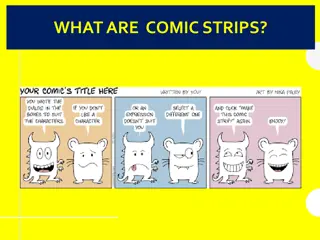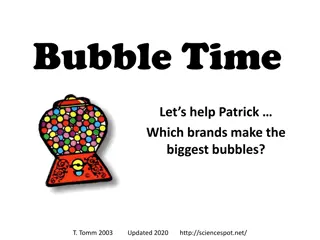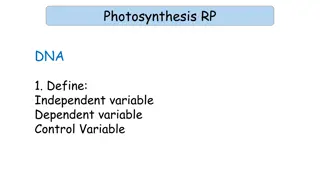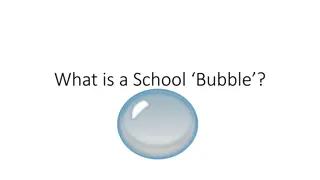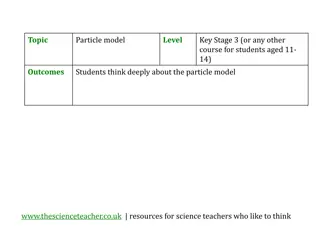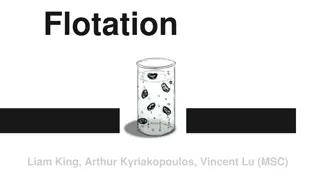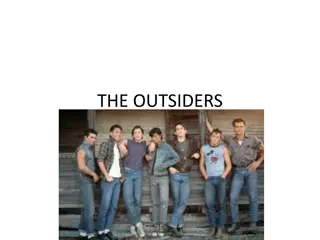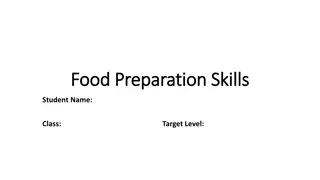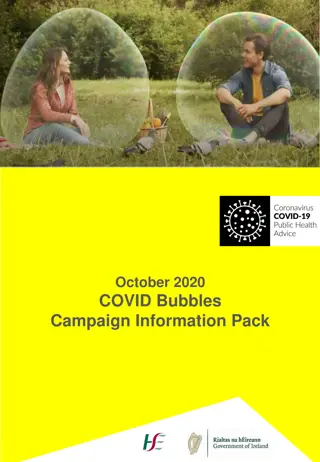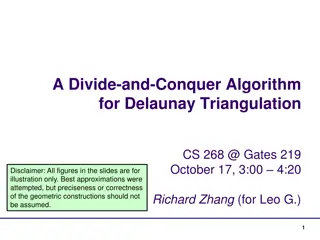
History of Financial Crises and Market Bubbles
Explore the evolution of financial crises from the 17th century to the modern era, analyzing key events, theories, and figures such as John Law, Hyman Minsky, and Eugene Fama. Understand the concept of market bubbles and their impact on economies through a historical lens. Discover valuable insights from renowned economists and scholars to navigate the complexities of financial markets.
Download Presentation

Please find below an Image/Link to download the presentation.
The content on the website is provided AS IS for your information and personal use only. It may not be sold, licensed, or shared on other websites without obtaining consent from the author. If you encounter any issues during the download, it is possible that the publisher has removed the file from their server.
You are allowed to download the files provided on this website for personal or commercial use, subject to the condition that they are used lawfully. All files are the property of their respective owners.
The content on the website is provided AS IS for your information and personal use only. It may not be sold, licensed, or shared on other websites without obtaining consent from the author.
E N D
Presentation Transcript
, . (1620) .
1630. 1720. 1825, . H (long depression) 1870. (Great Depression) 1930. H 1991. 1997. dot-com 1990. 2008 circa 2023-24
De La Vega, 1688, Confusion de Confusiones John Law, 1705, Money and trade considered: with a proposal for supplying the nation with Money Henry Thornton, 1802, An Enquiry into the Nature and Effects of the Paper Credit of Great Britain J.A. Hobson, 1909, The Industrial System Fisher, I. (1933) "The Debt-Deflation Theory of Great Depressions," Econometrica 1 (4): 337-57 Fisher, Debt deflation theory Hyman Minsky, 1986, Stabilizing an Unstable Economy Furman, J. and Stiglitz, J. (1998) Economic Crises: Evidence and Insights from East Asia , Brookings Papers on Economic Activity, Vol. 29, No. 2, pp. 1 136. Robert Shiller, 2000, Irrational Exuberance, Princeton: Princeton University Press Dow S., 2017, Central banking in the twenty-first century. Cambridge Journal of Economics, 41 (6), pp. 1539-1557. Gennaioli, Nicola, Andrei Shleifer, and Robert Vishny. 2015. "Neglected Risks: The Psychology of Financial Crises." American Economic Review, 105 (5): 310-14 Samuel G. Hanson, Anil K Kashyap, and Jeremy C. Stein, 2011, A Macroprudential Approach to Financial Regulation , Journal of Economic Perspectives, 25 (1). pages 3 28
Cihan Bilginsoy, 2015, A history of financial crises: dreams and follies of expectations, 2 . John Kenneth Galbraith, 1996, A short history of financial euphoria, New York: Penguin, 2 . Robert Z. Aliber; Charles Poor Kindleberger; Charles Poor Kindleberger, 2011, Manias, panics, and crashes: a history of financial crises, London: Palgrave Macmillan . 213-228) Friedman, Milton, 1990, The Crime of 1873 Journal of Political Economy, Vol. 98 (6), . 1159-1194 Richard Koo, 2009, The Holy Grail of macroeconomics: lessons from Japan's great recession, Singapore: John Wiley and sons Joseph E. Stiglitz, 1999, Reforming the Global Economic Architecture: Lessons from Recent Crises , The Journal of Finance, Vol. 54, No. 4, . 1508-1521
Karl Mannheim Karl Niebyl Werner Stark . Joseph Schumpeter Paul Samuelson . -
- i (Bubbles); - ( ) . A bubble is conventionally defined as market prices which are not supported (cannot be explained) by an analysis of the fundamentals of the asset. By fundamentals we mean a valuation of the asset that we believe reflects its true value, and may (under conditions), in time become its true price. , , , . The departure from this valuation by the market is, to some degree at least, a psychological phenomenon. In general these events are viewed as outbursts of irrationality: self-generating surges of optimism that pump up asset prices and misallocate investments and resources to such a great extent that a crash and major financial and economic distress inevitably follow. (Garber, 2001, 3)
X ; ; I don t even know what a bubble means. These words have become popular. I don t think they have any meaning. (Eugene Fama, interview in January 2010). Eugene Fama efficient-market hypothesis (EMH) . A bubble may be defined loosely as a sharp rise in price of an asset or a range of assets in a continuous process, with the initial rise generating expectations of further rises and attracting new buyers (Kindelberger, 1987, vol. I, 281) Kindleberger 1630 .
(bubbles) Fama bubbles and crises . . . James Galbraith (bubbles) . (bad institutional design). (signals) (incentives).
bubbles The term has been commonly applied since the 17thcentury to any unsound commercial undertaking accompanied by a high degree of speculation. (Palgrave dictionary, vol. I, 1894, 182-3) First of times the term has been used is in relation to the tulip prices in Holland in the 1630s. Then the term was used in conjunction with the Mississippi scheme of 1719-1720 in France. At the same time in England the term was used in relation to the South Sea Bubble, of 1720. The term has been in use ever since in the popular and academic press.
Methods of analysis: what can an economist do to analyse each situation? Pluralism of method and evidence Quantitative and qualitative data Historical example and abstract theorising Induction and Deduction in theorising Use of alternative interpretative devices Reasoned argument. Building logical sequences of events and consequences Open Systems: Understanding the social realm and exploring the insight of key concepts Closed systems: Building (mathematical) models and fitting them to real world data By example. Finding historical or contemporary parallels and judiciously extrapolating. Synthetically. By using a mix of the above techniques.
Reasoned argument: Closed Systems Method Method: Theorists build a mathematical model that clearly distinguishes between endogenous and exogenous variables. Data Data: Quantitative, fit of model to data. Context of use Context of use: Explaining past data series or trying to understand a particular mechanism in the economy. Heuristics Heuristics: Simple models that you can fit to data or use to discuss the effects of changes on a limited set of variables. Example Example: An IS/LM analysis of conducting monetary policy. Limits of approach Limits of approach: It is highly abstract by construction and its unclear if it is capturing the relevant variables for the situations you may wish to use it. Closed Systems
Example: The IS/LM model Endogenous variables: determined in the model. Exogenous variables: considered given in the model. LM: combinations of Y and r whereby money market is in equilibrium IS: combinations of Y and r whereby commodities market is in equilibrium Intersection E: equilibrium in both markets
Monetary influences: shifts in LM Let s consider an increase in money supply We start at point A. Increase in money supply creates excess supply for money, which causes r to fall I increases Y rises C rises Lower r and higher Y Mdis higher until it is equal to new Ms New equilibrium at B: lower r, higher Y
Reasoned argument: Open Systems Open Systems Method Method: Theorists discuss possible factors that are linked to observed phenomena. Data Data: Qualitative, textual and historical. Context of use Context of use: Framing policy decisions, discussion of alternatives, and informing selection of specific models to be used in quantitative analysis. Heuristics Heuristics: Understandings about the nature of social and economic reality that act as key fundamental concepts. Example Example: the distinction between different types of uncertainty among the post Keynesians. Limits of approach Limits of approach: Cannot really be used to do quantitative or even, on occasion, qualitative predictions of events.
Open systems Critical Realism & Tony Lawson Link between ontology and methods of use. Central question: are we using the right tool for the right job? Mainstream closed system thinking has a deep systemic problem. Wrong uses of method given the nature of social reality. Open system theorising defines what method is appropriate for the nature of social reality. Systemic thinking is still possible, and it is there to uncover deep elements of the economic system that we live in. Some questions (i.e. measuring how a change in basis point interest rates influences inflation) are simply mis-specified as they are not closed system event regularities.
Open Systems post-Keynesian variety (Sheila Dow/Victoria Chick) Opening happens in different ways. A closed system has the following characteristics: All relevant variables can be identified; The boundaries of the system are definite and immutable; ie. Endogenous and exogenous variables are clearly defined and fixed; Only the specified exogenous variables affect the system, and they do this in a known way; Relations between variables are either knowable or random; Economic agents are treated atomistically; The nature of the agent is constant; The structure of the relationships between the components is knowable or random. The structural framework in which agents act is a given. The focus is to identify properly the problem under question and the method to use. Closed systems have their uses, but one should be aware of the dangers involved.
Example: Different types of uncertainty Definition of Risk: Definition of Risk: I know the set of possible states of the world that can happen A state of the world is a description that takes into account relevant aspects for that decision I know the effect each state of the world will have on my payoff I know the effect they have on the decision I make I know the probability with which each state of the world will happen Definition of weak uncertainty: Definition of weak uncertainty: I know the possible events that can happen, and the effect on my payoff But I don t know their probability Definition of strong uncertainty: Definition of strong uncertainty: We don t even know all the relevant states of the world, let alone their probability
By Example By Example. Finding historical or contemporary parallels and comparing/extrapolating. Adam Smith s method of doing economics: analytical examples in historical time used to build a general broad narrative. Economists of all schools substantially use past experience when doing theory and empirical analysis today to understand and test their understanding of what is happening. Some only focus on the past as data to test their closed system models. Others investigate the historical conditions of a boom, bubble or crush and see if there are parallels in institutions or human/social behaviour then that can explain what happened today. Examples are more useful in situations that are uncommon and we do not experience frequently. There past discussions that retain memories of the problem and the solutions sought could be very useful for dealing with a situation today.
The Great depression and the 2008 financial crisis. Are there parallels? The money multiplier during the great depression and the current (2007-13) crisis. Are there parallels? What are they? Did it collapse in the same way or are the similarities only superficial?
The use of contrasting perspectives Economists from different schools of economic thought place different emphasis to the use of the tools discussed above. Some see closed system closed system model building as the only proper way of doing analysis. They do not see historical examples as useful (only as material providing quantitative data). They do not see open systems as a scientific approach to economics. Model selection is dictated by goodness of fit of each model to data. They find limited use to an understanding of broad historical context. Others find that closed system model building is not suited for social analysis. They concentrate on an open system approach an open system approach.
Ideology, theory and point of view-a complex relationship. Werner Stark s position of embedding ideology to historical reality. The identification of ideology with theoretical positions has diachronic links, but also experience change- language is at times more shared by contemporary ideological rivals than by sympathetic readers across ages that identify with the same (broadly) ideological position. Issues of incommensurability between positions emanating from different theoretical systems (Marxist vs neoclassical) and due to historical and social change.
Competing interpretations We will investigate these crises from perspectives that differ in the following way: They have different ideological bias. Some are in favour of free markets others in favour of government intervention. They have different methodological positions. Some employ models and closed system logic, others use a more open system approach. They have different ontological positions. Their belief about the nature of social reality is different. They understand historical context (both then and now) in different ways.



